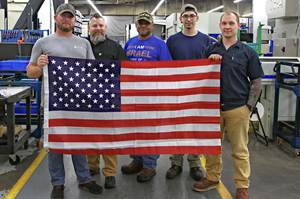Data from a Machine-Monitoring System Can Help Human Resource Management
Advanced Machining used FactoryWiz from Refresh Your Memory Inc. to go from simply buying more equipment when facing production constraints to becoming more efficient with machine monitoring.
Share






As a supplier of machine monitoring software, we find that customers are primarily preoccupied with concerns over machine performance and utilization. This is why overall equipment effectiveness (OEE) is a popular measure of shopfloor activities. Most dashboards showing production results include OEE ratings, at least as an option.
However, the productivity (and profitability) of a machining operation has as much to do with human behavior, especially how well machine operators are performing their duties to keep machines running and jobs on schedule.
The data from some machine monitoring systems can also help a machining company enhance the contribution of shopfloor personnel in the productivity equation. In fact, this data can be a valuable tool for many human resource (HR) functions such as conducting employee performance reviews, managing incentive programs, setting goals and identifying training needs. Just as data gathered by a computer network from connected machines can lead to better decisions about a manufacturing process when that data is analyzed and reported effectively, this data can also lead to better decisions about engaging and motivating a workforce. Implementing a machine monitoring system makes performance measurable, objective and visible. The same characteristics apply to the study of operator performance—its basis can now be measurable, objective and visible.
S. Scott Shortess, the COO of Advanced Machining, a 55-person job shop in Owasso, Oklahoma, is a user whose experiences in this area are particularly telling.
“At first, we were interested in machine monitoring because we tended to respond to production constraints by simply buying more equipment, but our profit picture wasn’t getting any better,” he says. “We needed more efficiency, not more machines. With the monitoring system in place, we could see where downtime, planned or unplanned, was really hurting us. We found kinks in our workflow and started straightening them out. We could also see how much operator behavior had to do with machine output.”
This led Advanced Machining to take a two-pronged approach to making effective use of the data from machine monitoring. One was a renewed focus on process improvements, especially as a result of more precisely targeted lean manufacturing techniques such as setup reduction and “next job readiness.” The other prong was making the shop’s profit-sharing incentive program more effective. Mr. Shortess says that data-driven performance reviews and corresponding payout policies were a big part of this effort. Here are some additional observations and advice he has to offer:
- Build benchmarks and set goals around attainable improvements linked to customer, company and personal benefits. Your good decisions help everyone and maximize rewards.
- Foster dialogue and keep it positive. How can we work together to help you do better where the facts show room for improvement?
- Use data to ask the right questions and get the real reasons for shortcomings. Good data protects everyone and defuses the blame game.
- Let shopfloor visibility generate some healthy competition among employees. Keeping score should reflect that everybody can win.
- Shops should think about the HR benefit when evaluating machine monitoring, but it is okay to focus on improving OEE first. Just don’t forget about it! And keep HR people in the loop.
- Don’t let data-driven incentive programs get stale. Review goals and adjust the performance targets often. Your machine-monitoring supplier should be able to help you tweak reports for this.
Mr. Shortess also acknowledges that a system set up to help employees succeed doesn’t guarantee that all of them will. “Letting an employee go is one of the toughest decisions any manager has to make. Data from a monitoring system helps us spot that things are not going in the right direction, guides us in efforts to turn things around, but also sets an endpoint if it comes to that,” he says.”
Related Content
Inside Machineosaurus: Unique Job Shop with Dinosaur-Named CNC Machines, Four-Day Workweek & High-Precision Machining
Take a tour of Machineosaurus, a Massachusetts machine shop where every CNC machine is named after a dinosaur!
Read MoreManufacturing Technology and Training in Europe
NTMA’s European Tech Tour exposed attendees to the latest technology and traditional training methods used by European manufacturers.
Read MoreShop Tour Video: You've Never Seen a Manufacturing Facility Like This
In the latest installment of our “View From My Shop” series, explore Marathon Precision’s multi-process approach to manufacturing, where blacksmiths and hand-forged dies meet state-of-the-art CNC machining. Discover how restoring classic muscle cars and building custom art projects creates a dynamic shop culture — and draws top talent to this unique and innovative metalworking facility.
Read MoreFinding Skilled Labor Through Partnerships and Benefits
To combat the skilled labor shortage, this Top Shops honoree turned to partnerships and unique benefits to attract talented workers.
Read MoreRead Next
Machine Shop MBA
Making Chips and 91ÊÓƵÍøÕ¾ÎÛ are teaming up for a new podcast series called Machine Shop MBA—designed to help manufacturers measure their success against the industry’s best. Through the lens of the Top Shops benchmarking program, the series explores the KPIs that set high-performing shops apart, from machine utilization and first-pass yield to employee engagement and revenue per employee.
Read MoreLast Chance! 2025 Top Shops Benchmarking Survey Still Open Through April 30
Don’t miss out! 91ÊÓƵÍøÕ¾ÎÛ's Top Shops Benchmarking Survey is still open — but not for long. This is your last chance to a receive free, customized benchmarking report that includes actionable feedback across several shopfloor and business metrics.
Read MoreAMRs Are Moving Into Manufacturing: 4 Considerations for Implementation
AMRs can provide a flexible, easy-to-use automation platform so long as manufacturers choose a suitable task and prepare their facilities.
Read More


















